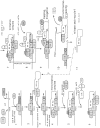The basic RNA polymerase II transcriptional machinery
- PMID: 1633439
- PMCID: PMC6057384
The basic RNA polymerase II transcriptional machinery
Abstract
All genes encoding proteins in eukaryotes are transcribed by RNA polymerase II. The first step in analyzing transcriptional regulation requires understanding the general mechanisms of RNA polymerase II-specific gene transcription. The basal promoter, a template containing a TATA box devoid of upstream regulatory sequences, has been used to identify and characterize the factors which, together with RNA polymerase II, govern transcription in mammalian systems: TFIIA, TFIIB, TFIID, TFIIE, TFIIF, TFIIG, TFIIH, and TFIIJ. Interactions between regulatory transcription factors and basal elements of the transcriptional machinery affect the transcriptional rate in a positive or negative fashion. As these multiple proteins are purified, and their coding sequences are isolated, we come closer to reproducing these processes in vitro with pure components, and thus to elucidating the complex interactions among them.
Figures

Similar articles
-
A mouse in vitro transcription system reconstituted from highly purified RNA polymerase II, TFIIH and recombinant TBP, TFIIB, TFIIE and TFIIF.Eur J Biochem. 2001 Aug;268(16):4527-36. doi: 10.1046/j.1432-1327.2001.02378.x. Eur J Biochem. 2001. PMID: 11502214
-
Factors involved in specific transcription by mammalian RNA polymerase II: identification of general transcription factor TFIIG.Proc Natl Acad Sci U S A. 1990 Dec;87(23):9158-62. doi: 10.1073/pnas.87.23.9158. Proc Natl Acad Sci U S A. 1990. PMID: 2251257 Free PMC article.
-
Factors involved in specific transcription by mammalian RNA polymerase II. Identification and characterization of factor IIH.J Biol Chem. 1992 Feb 5;267(4):2786-93. J Biol Chem. 1992. PMID: 1733973
-
Molecular genetics of the RNA polymerase II general transcriptional machinery.Microbiol Mol Biol Rev. 1998 Jun;62(2):465-503. doi: 10.1128/MMBR.62.2.465-503.1998. Microbiol Mol Biol Rev. 1998. PMID: 9618449 Free PMC article. Review.
-
The general transcription machinery and general cofactors.Crit Rev Biochem Mol Biol. 2006 May-Jun;41(3):105-78. doi: 10.1080/10409230600648736. Crit Rev Biochem Mol Biol. 2006. PMID: 16858867 Review.
Cited by
-
Sfh1p, a component of a novel chromatin-remodeling complex, is required for cell cycle progression.Mol Cell Biol. 1997 Jun;17(6):3323-34. doi: 10.1128/MCB.17.6.3323. Mol Cell Biol. 1997. PMID: 9154831 Free PMC article.
-
Unusual charge configurations in transcription factors of the basic RNA polymerase II initiation complex.Proc Natl Acad Sci U S A. 1993 Jun 15;90(12):5593-7. doi: 10.1073/pnas.90.12.5593. Proc Natl Acad Sci U S A. 1993. PMID: 8516305 Free PMC article.
-
C-terminal domain (CTD) of RNA-polymerase II and N-terminal segment of the human TATA binding protein (TBP) can mediate remote and proximal transcriptional activation, respectively.Nucleic Acids Res. 1993 Dec 11;21(24):5609-15. doi: 10.1093/nar/21.24.5609. Nucleic Acids Res. 1993. PMID: 8284205 Free PMC article.
-
Isolation and characterization of Aquaporin 1 (AQP1), sodium/potassium-transporting ATPase subunit alpha-1 (Na/K-ATPase α1), Heat Shock Protein 90 (HSP90), Heat Shock Cognate 71 (HSC71), Osmotic Stress Transcription Factor 1 (OSTF1) and Transcription Factor II B (TFIIB) genes from a euryhaline fish, Etroplus suratensis.Mol Biol Rep. 2018 Dec;45(6):2783-2789. doi: 10.1007/s11033-018-4350-1. Epub 2018 Sep 7. Mol Biol Rep. 2018. PMID: 30194561
-
Identification of a mouse protein whose homolog in Saccharomyces cerevisiae is a component of the CCR4 transcriptional regulatory complex.Mol Cell Biol. 1995 Jul;15(7):3487-95. doi: 10.1128/MCB.15.7.3487. Mol Cell Biol. 1995. PMID: 7791755 Free PMC article.
References
-
- Ahearn J. M., Bartolomei M. S., West M. L., Cisek L. J., and Corden J. L. (1987), J Biol Chem 265,425–437. - PubMed
-
- Arias J. A., Peterson S. R., and Dynan W. S. (1991), J Biol Chem 266, 8055–8061. - PubMed
-
- Aso T., Vasavada H. A., Kawaguchi T., Germino F. J., Ganguly S., Kitajima S., Weissman S., and Yasukochi Y. (1992), Nature 355, 461–464. - PubMed
-
- Bagchi S., Weinmann R., and Raychaudhuri P. (1991), Cell 65, 1063–1072. - PubMed
-
- Bartholomew B., Dahmus M. E., and Meares C. F. (1986), J Biol Chem 261, 14226–14231. - PubMed
Publication types
MeSH terms
Substances
LinkOut - more resources
Full Text Sources
Molecular Biology Databases
Research Materials
